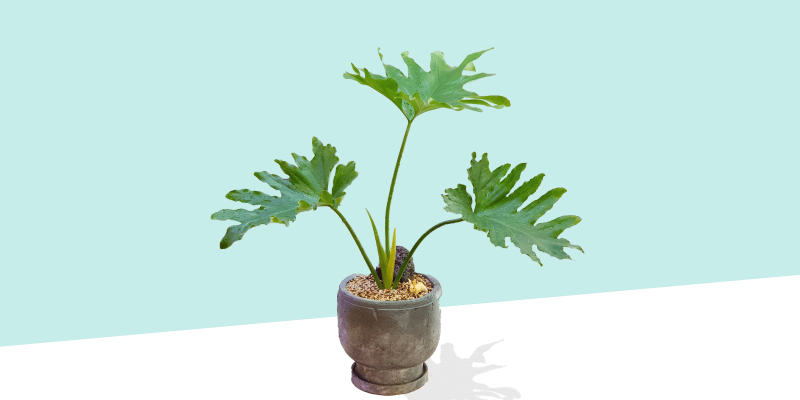Philodendron selloum (or “Tree Philodendron”) is a fantastic, bright tropical houseplant with beautiful split leaves that lightens any room you place it in.
In this guide, we’ll cover how to take care of your Philodendron selloum, the most common issues that come up, and its unique heat-producing flowers!
This is a fantastic plant for beginners, so if you’ve had trouble keeping an indoor plant looking vibrant in the past, all is not lost!
Table of Contents
Philodendron Selloum Care Guide
History, habitat, and characteristics
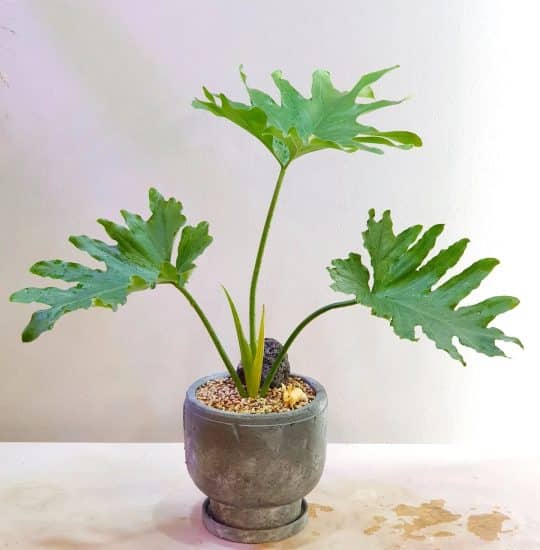
Ever heard the phrase “tree-loving”? In the botanical world, we’d just say “Philodendron”. This genus of plants is made up of over 450 different species, and until recently, you might count Philodendron selloum among them.
What’s the catch?
Well, the science that separates plants into distinct taxonomies is always changing. And as we learn from DNA, discover new species, and reconsider those we already know, we sometimes update these categories.
With Philodendron selloum and Philodendron bipinnatifidum, botanists discovered they’re actually just one plant. So not only split-leaf, but split-species!
These Philodendron plants (along with Philodendron xanadu) were in their own subgenus known as Meconostigma. In the last decade, it was discovered that this is actually its own distinct genus, and now they’ve been recategorized yet again this time as Thaumatophyllum. So the humble Philodendron selloum (also called the Tree Philodendron) is no longer ‘tree-loving,’ but instead, Wonder Leaf (Thaumatophyllum bipinnatifidum).
We’ll refer to this plant by its original name, Philodendron selloum, throughout the article. Even though the name has updated, the plant and its care are the same!
When this tropical plant is grown indoors as a houseplant, Philodendron selloum usually grows more slowly to heights of up to 4 feet and with large, glossy leaves 6” to 12” wide. Its leaves are also known for their unique cutouts that create a striking, dappled shadow pattern when exposed to bright light.
As with many members of the Araceae family, they can release microscopic crystals of calcium oxalate upon contact with skin, so always handle carefully and keep out of reach of pets and children.
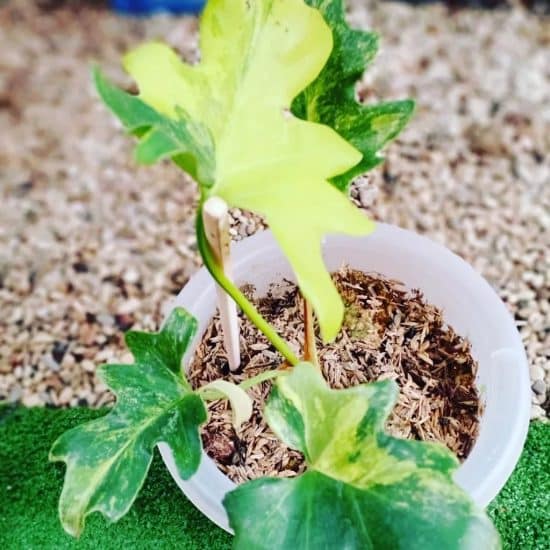
It is easy to mistake P. selloum for other varieties of philodendron, such as Philodendron Hope selloum or P. Xanadu. While all of these varieties have large, lobed leaves that fans out into finger-like extensions, they each have their own unique characteristics.
But whether you have a Lacy Tree Philodendron or Philodendron Selloum, they all have a fantastic ability to filter toxins (like Xylene or Toluene) from your air.
Light
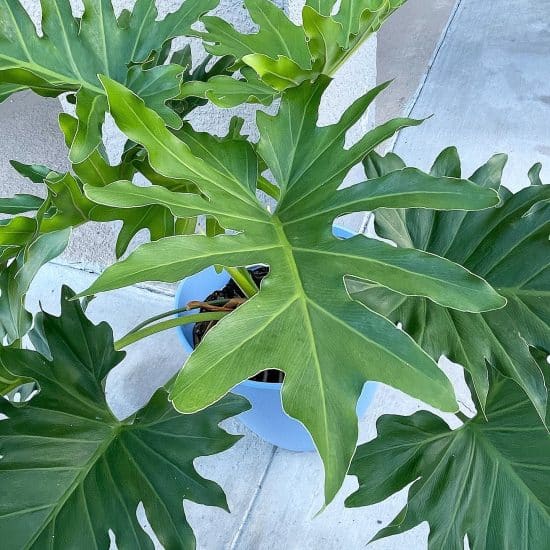
Philodendron selloum actually does pretty well in a variety of lighting conditions. It does prefer bright, indirect sunlight, but can also tolerate low-light areas better than a lot of other houseplants.
So how do you know if your Phileodendron Selloum is placed in the right spot?
Well, when Philodendron selloum receives the right light, it will display dark green, glossy leaves with a hint of purple or mauve. If light conditions are too low, you’ll notice paler, dull leaves that are smaller and less vibrant.
Unlike a lot of indoor plants, where we’ll recommend not misting or wetting the leaves, Philodendron selloum does benefit from a damp cloth, or misting and wiping away any collected dirt or dust to promote optimal photosynthesis.
Lighting tips:
- Rotate your Philodendron selloum regularly to ensure all foliage has access to light.
- Avoid direct sun to prevent leaf burn.
- If the leaves become sparse and spindly, place your plant in an area with more indirect light so it doesn’t need to reach quite so far for some sun.
Water
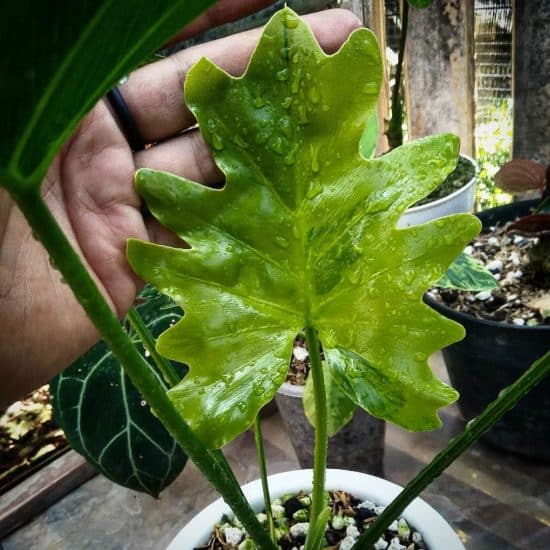
Staying consistent with the right amount of water is key to keeping your Philodendron selloum happy and healthy. The best way to judge when your plant needs hydration is to place a finger in the first few inches of soil and check if it’s dry. If so, it’s time to water!
Underwatering is just as damaging as overwatering. If the leaves of your plant start to droop and dry brown spots form on the edges of leaves, it’s time for an adjustment. Increase the amount of water slowly as you recalibrate your plant care.
Tips for watering Philodendron selloum:
- Feel the top few inches of soil: if they’re dry, it’s time to water
- Water more frequently during the growing season, up to once a week (if not more frequently)
This plant does better than most with soggy soil, but don’t let it stay wet for too long.
Temperature and humidity
As Philodendron selloum is a subtropical plant native to South American forest floors, it requires a specific range of temperature and humidity to grow indoors. Studies have shown that mimicking the conditions of a plant’s native environment helps it to thrive, so let’s talk about how to do just that.
Temperature: Tree Philodendron likes to stay between 65-80°F (18-27°C) and can adapt to short periods of temperature outside of this range. However, prolonged exposure to these conditions may lead to wilting of the leaves and indicate that the plant needs to be moved to a warmer area. Very low temperatures must be avoided: Philodendron selloum will not survive for long if exposed to frost.
Humidity: Philodendrons are a bit pickier here and crave a much higher level of humidity than we’re usually comfortable in. In order to simulate their natural rainforest habitat, your philodendron will need a humidity level of around 50-80% – anything less than 40% really won’t cut it. Luckily, this doesn’t have to be as challenging as it may sound. To reach that level, you can invest in a humidifier or set up a simple pebble tray – just pile some rocks and water in a tray, and the stones (with greater surface area) will evaporate the water, creating a makeshift greenhouse for your Philodendron selloum.
Tips:
- Keep your Philodendron selloum away from vents, fireplaces, and drafty windows.
- Optimal humidity levels for philodendron selloum is between 50 – 75%.
- In order to maintain desired humidity levels in the same room, use a humidifier or group houseplants together.
Soil and planting
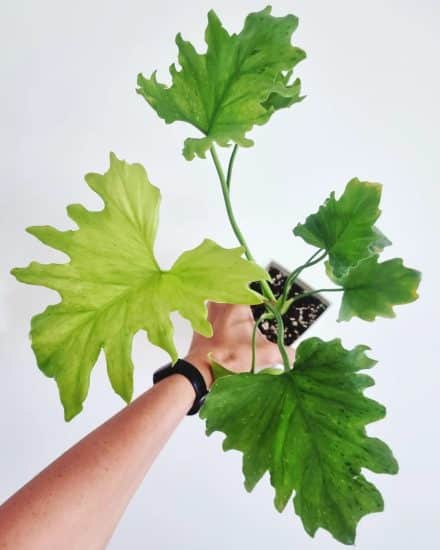
Philodendron selloum prefers soil that is organic, slightly acidic, and consistently moist but well-draining. That’s a mouthful. In accordance with a study published by the National Academy of Science, a pH range between 5.5 and 7.5 is ideal.
Nutrient requirements must also be considered, as this plant is a heavy feeder. Liquid and chemical fertilizers are viable options; however, when using liquid fertilizers, be sure to dilute the solution to 50% strength. Avoid applying during the winter when the plant is growing more slowly as this can overwhelm the root structure. You’ll want to instead use during the growing season (spring/summer) at least once per month.
Potting & re-potting
When it comes to finding the right pot for your Philodendron selloum, look for one with sizable drainage holes. If you notice roots on the surface, coming over the sides, or through the holes, it’s time to consider repotting.
When repotting, make sure to use fresh potting soil, and only choose a pot that is 2 inches larger than the previous pot.
An ideal soil mix for Philodendron selloum includes:
- Potting soil (not garden soil)
- LECA: provides aeration to the soil, increased root mobility, and water retention
- Horticultural charcoal: improves aeration, protects against overwatering
Let’s move on to our Philodendron Selloum propagation guide, and then we’ll cover the common issues that come up most frequently.
Propagation guide
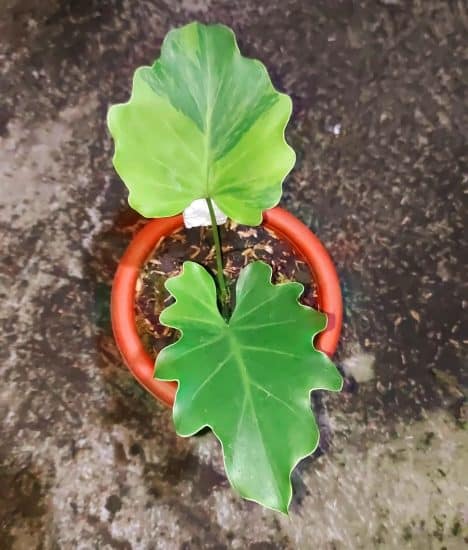
Propagating Philodendron selloum is a simple process that requires just a few materials and not much time.
Stem cutting is the most popular and common way to propagate Philodendron selloum, just like most indoor plants. We’ll take a cutting from the stem, making sure that nodes are included, and then place that cutting in a growth medium ranging from peat moss, water, to LECA or even potting soil. Feel free to experiment!
Your Tree Philodendron stem cutting should be kept in a spot with bright indirect light, and it should take around two weeks for the cutting to form roots. After you see the root structure form, it’s time to pot your new plant!
Materials needed:
- Philodendron selloum stem cutting with 1-3 nodes
- Rooting hormone (optional)
- A container
- Gloves
- Sterilized shears (before & after)
- Soil, peat moss, water, or LECA
Steps:
- Put on gloves, and using sterilized shears, cut a stem with 1-3 nodes from the mother plant.
- Dip the cutting into the rooting hormone (optional).
- Place the cutting in soil, moss, water, or LECA.
- Water and keep the propagation in a warm, bright spot, keeping the soil consistently moist. You can cover the container with a small bag or even a cut soda bottle.
- After two weeks, the cutting should have rooted and be ready for transplanting.
(Note: If you notice aerial roots on your cutting, they’re helpful, but we’re really looking for the leaf stem node, so make sure it’s included!)
Common issues
In this section, we’ll cover the most common issues seen with Philodendron selloum, most of which are caused by water issues (soggy soil), not enough indirect light, or too much direct sun.
Yellowing Leaves
Yellowing leaves on Philodendron selloum can unfortunately indicate both over & under-watering. The way to differentiate is to inspect the leaves for browning or crispiness. Crispy leaves are almost always due to underwatering. If they’re drooping, soft, and brown, it’s likely you need to let that soil dry out.
Pale Green Leaves
Pale green leaves on Philodendron selloum can be an indication of a lack of fertilizer or too much sunlight. Adjust your plant’s environment accordingly to guarantee optimal health – if you find your plant needs more fertilizer, choose a balanced fertilizer with macronutrients to give it all the nutrients it needs, and water the plant just before applying.
Diseases and pests
These are often spotted when your plant has already been weakened, but in most cases, by addressing the underlying causes (as well as the symptoms), your plant can still be restored to its previous happy ways. Prevention is best, so if you’ve had issues in the past, you might consider using Neem oil as a preventative.
If despite your best efforts, you’re seeing signs of bugs or fungus, let’s cover the common solutions.
Root rot
Root rot is a common issue with all houseplants, including Philodendron selloum. It’s almost always caused by extended exposure to overly moist or waterlogged soil. You’ll notice the leaves turning yellow, growth slowing or halting completely, and the roots of the plant growing brown and mushy.
If you’re noticing this:
- Remove the plant from its pot and shake away excess soil.
- Examine the roots for signs of browning or mushiness.
- Clean the roots off with water.
- Cut away any affected roots using sterilized scissors (make sure to sterilize again with alcohol or boiling after)
- Repot the plant in a fresh houseplant soil mix.
Aphids
Aphids are small insects that often reside on the underside of leaves. To prevent them from taking hold, wipe down both sides of your philodendron’s leaves with a damp cloth and some neem oil. If aphids are already present, they can be removed with water or a Q-tip in alcohol.
Spider Mites
A buildup of spider mites will result in webbing and yellow and white spots on the leaves as they feed, draining life from the plant. To combat as well as remove spider mites, refer to the in-depth guide from the Clemson College of Agriculture, Forestry and Life Sciences in the Sources section below for more information and steps.
Mealybugs
These look a lot like little clusters of webbing or cotton balls, and they tend to avoid the light so you’ll see them underneath a leave or near dying leaves. Removal is easy: find your own cotton ball (!) and soak it in a bit of rubbing alcohol and then remove.
Conclusion
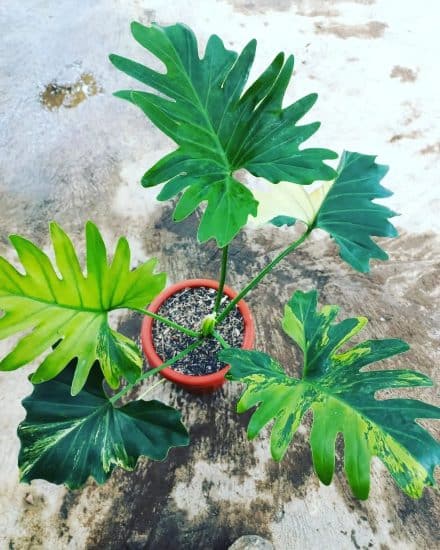
That’s it for our Philodendron selloum care guide. We’ve gone through the many varieties of Tree philodendron (even if many of them aren’t even technically Philodendrons anymore!), how to deal with the most common issues that come up, and how to grow a few more of your own from stem cuttings.
This is a fantastic plant for a beginner because of its tolerance for a variety of lighting and water conditions, but it does have irritating calcium oxalate crystals, so be careful with handling and around pets and kids.
If you have any questions, please drop us a line and get in touch. Remember: bright indirect light and a finger in the soil will solve 90% of your issues!
FAQ
How big does Philodendron selloum get?
Outside, they can easily grow more than 10 feet tall, and inside, they will grow to fill your space if you let them!
How do you care for a Philodendron selloum?
The short of it: bright indirect light, avoid direct sun, and make sure moist soil is given an opportunity to dry out.
How do you know if your Tree Philodendron has too much plant food?
The same as if there’s excessive fertilizer – you’ll notice the leaf tips burn and get crispy around the edges. This can also be a sign of acid or salty soil.
Is there a Philodendron selloum flower?
There is! They’re quite an interesting phenomenon in that they’re thermogenic and can get pretty warm (over 100 degrees!). They last only briefly, but put a hand near one if you do discover a flower, and you’ll be in for a treat.

